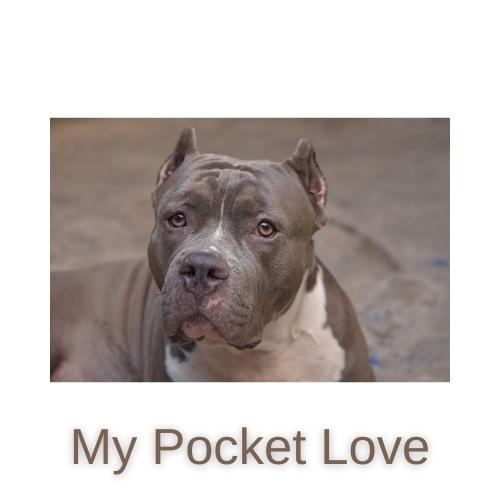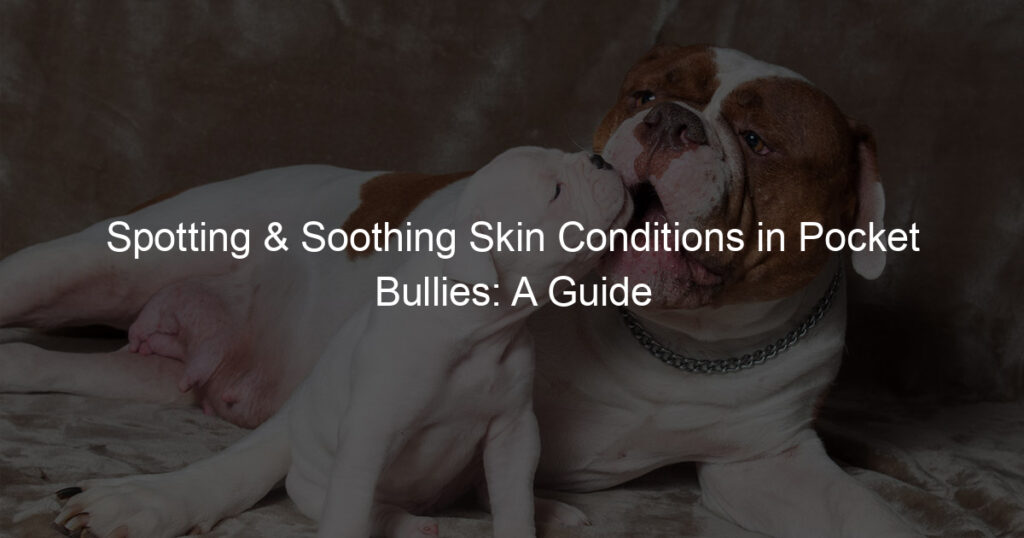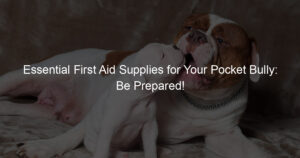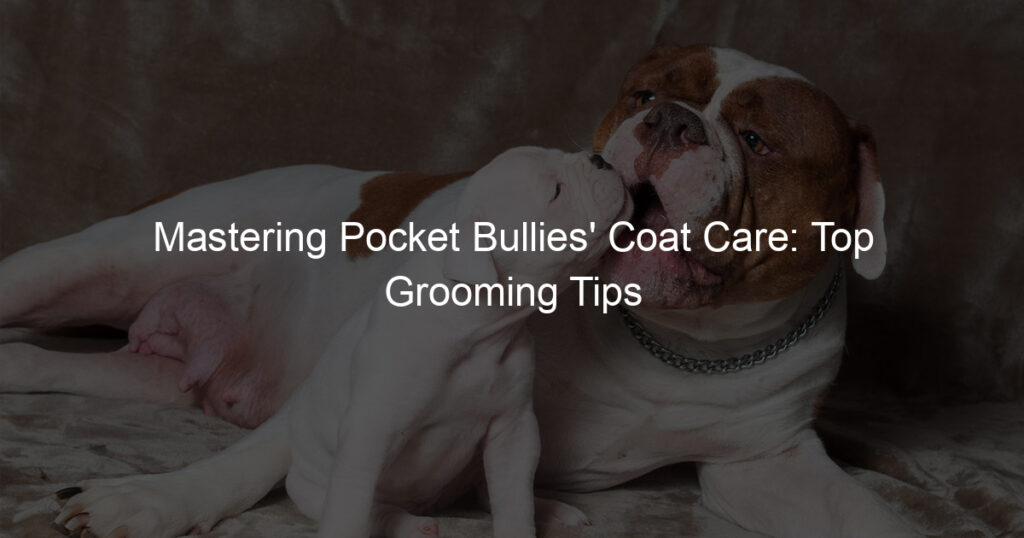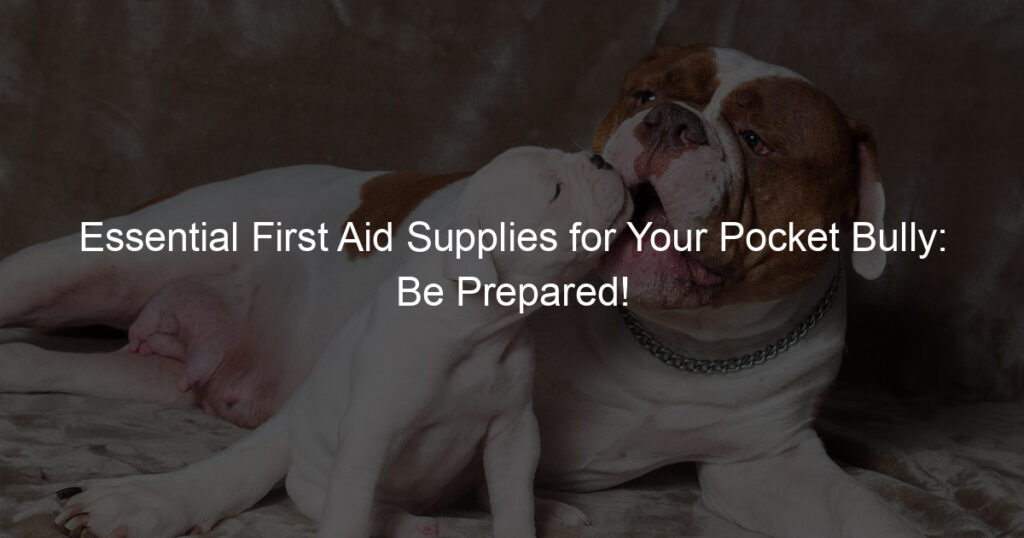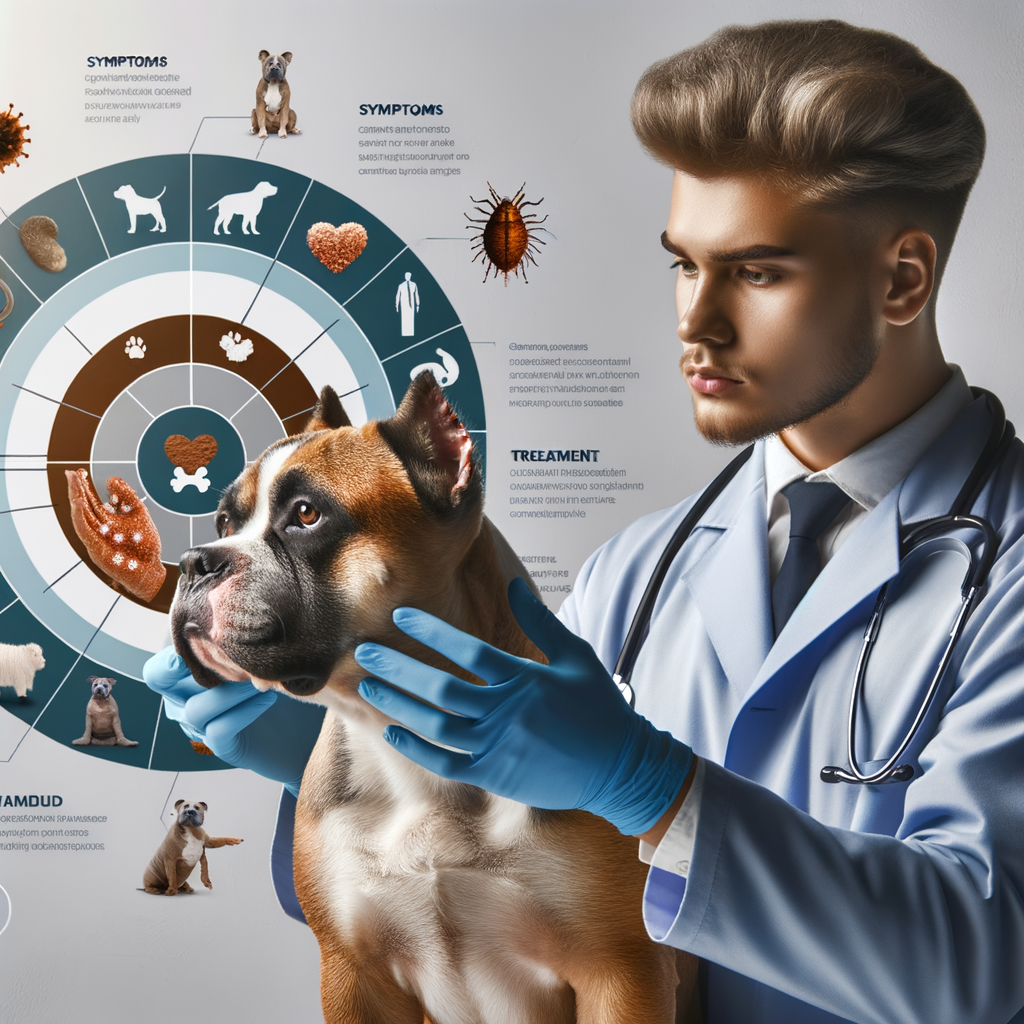
Introduction to Pocket Bullies Skin Conditions
Understanding the health of your Pocket Bullies breed dog is crucial. One of the most common areas of concern is their skin health. This post will provide an overview of the breed, the importance of skin health, and common skin problems they face.
- Overview of Pocket Bullies Breed
- Importance of Skin Health in Pocket Bullies
- Common Skin Problems in Pocket Bullies
The Pocket Bullies breed is a smaller version of the American Bully. They are known for their muscular build, short stature, and friendly demeanor. Despite their tough exterior, they are affectionate and loyal pets. They require regular exercise and a balanced diet to maintain their health.
Skin health is vital for Pocket Bullies. Their skin is their largest organ and serves as a protective barrier against infections and diseases. A healthy skin also contributes to their overall appearance and comfort. Regular grooming and check-ups can help maintain their skin health.
Pocket Bullies, like other breeds, can suffer from various skin conditions. Some of the most common include allergies, skin infections, and parasites. These conditions can cause discomfort and may lead to more serious health problems if not treated promptly.
Understanding these skin conditions and how to prevent them is key to keeping your Pocket Bullies healthy and happy. The following sections will delve deeper into identifying and treating these conditions.
Identifying Skin Conditions in Pocket Bullies
As a Pocket Bully owner, it’s crucial to be aware of the signs of skin conditions in your pet. Early detection can lead to more effective treatment and a happier, healthier dog. Let’s delve into the visual signs you should be on the lookout for.
Visual Signs of Skin Conditions
Visual signs are often the first indicators of a skin condition in your Pocket Bully. Here are the most common signs:
- Changes in skin color: Normal skin color for Pocket Bullies varies from pink to black, depending on the dog’s coat color. If you notice any unusual discoloration, such as redness or dark spots, it could be a sign of a skin condition. For instance, redness might indicate inflammation, while dark spots could signal a fungal infection.
- Presence of rashes or bumps: Rashes and bumps are not normal and could indicate a variety of skin conditions. Rashes might appear as red, itchy patches, while bumps could be small and hard or large and soft. They might be a sign of allergies, bacterial infections, or even tumors.
- Excessive scratching or licking: If your Pocket Bully is constantly scratching or licking a particular area, it’s likely that they’re trying to soothe an itch or discomfort. This behavior could indicate a skin condition like dermatitis or fleas.
Remember, these signs might not always mean your Pocket Bully has a skin condition. However, if you notice any of them, it’s best to consult with a vet to rule out any potential health issues.
By being vigilant and observant, you can help ensure your Pocket Bully’s skin stays healthy and vibrant. In the next section, we’ll discuss the behavioral signs of skin conditions in Pocket Bullies.
Behavioral Signs of Skin Conditions
Just as humans exhibit certain behavioral changes when they’re not feeling well, Pocket Bullies too, show signs that indicate they might be suffering from skin conditions. These signs are often subtle and can be easily overlooked. However, as a responsible pet owner, it’s important to stay vigilant and observe your Pocket Bully’s behavior closely. Here are some behavioral signs that might indicate your Pocket Bully is dealing with a skin condition:
- Change in Appetite
- Decreased Activity Level
- Unusual Aggression or Irritability
One of the first signs that your Pocket Bully might be suffering from a skin condition is a change in their appetite. They might eat less than usual or show a lack of interest in their favorite treats. This is because the discomfort caused by the skin condition can affect their overall well-being, leading to a decreased appetite.
Another sign to watch out for is a decrease in your Pocket Bully’s activity level. If your usually energetic and playful pet starts to spend more time resting and less time playing, it might be because they’re feeling unwell. Skin conditions can cause discomfort and fatigue, which can lead to decreased activity levels.
Lastly, if your normally friendly and sociable Pocket Bully starts to show signs of aggression or becomes unusually irritable, it could be a sign of a skin condition. The discomfort and itchiness caused by skin conditions can make your pet feel uncomfortable and irritable, leading to changes in their behavior.
Remember, these signs are not definitive proof of a skin condition. They could be indicative of other health issues as well. Therefore, if you notice any of these changes in your Pocket Bully’s behavior, it’s important to consult a vet immediately.
Treating Skin Conditions in Pocket Bullies
When it comes to treating skin conditions in Pocket Bullies, there are a number of effective home remedies that can be used. These remedies are not only easy to apply but also safe for your pet. Let’s take a closer look at some of these home treatments.
Home Remedies for Skin Conditions
Home remedies can be a great way to treat skin conditions in Pocket Bullies. They are cost-effective, easy to use, and most importantly, safe for your pet. Here are some of the most effective home remedies:
- Use of Oatmeal Baths: Oatmeal baths are a great way to soothe your pet’s skin. The natural properties of oatmeal can help to reduce inflammation and itchiness. To prepare an oatmeal bath, simply blend a cup of oatmeal into a fine powder and mix it with warm water. Allow your pet to soak in this mixture for about 15 minutes.
- Application of Coconut Oil: Coconut oil is known for its moisturizing and healing properties. It can help to soothe dry, itchy skin and promote healing. Simply apply a small amount of coconut oil to the affected area once or twice a day.
- Proper Grooming and Hygiene Practices: Regular grooming and maintaining good hygiene practices can go a long way in preventing skin conditions. This includes regular baths, brushing to remove dead skin and hair, and keeping your pet’s bedding clean.
Remember, while these home remedies can be effective, it’s important to consult with your vet if your Pocket Bully’s skin condition doesn’t improve or worsens. Your vet can provide additional treatments and advice to help your pet.
Medical Treatments for Skin Conditions
When home remedies aren’t enough to treat your Pocket Bully’s skin conditions, it’s time to consider medical treatments. These treatments are often more powerful and can help your pet feel better faster. Let’s explore some of the most common medical treatments for skin conditions in Pocket Bullies.
- Topical Creams and Ointments
- Oral Medications
- Specialized Veterinary Procedures
Topical creams and ointments are medicines that you apply directly to your Pocket Bully’s skin. They can help to soothe itching, reduce inflammation, and fight off infections. Some creams and ointments are available over-the-counter, while others require a prescription from your vet. It’s important to follow your vet’s instructions when using these products to ensure they’re safe and effective.
Oral medications are another option for treating skin conditions in Pocket Bullies. These are medicines that your pet takes by mouth. They can be used to treat a variety of conditions, including allergies, bacterial infections, and fungal infections. Like topical treatments, some oral medications are available over-the-counter, while others require a prescription.
In some cases, your Pocket Bully may need a specialized veterinary procedure to treat their skin condition. This could include things like skin biopsies, allergy testing, or surgical removal of skin growths. These procedures are typically performed by a vet and can provide a more definitive solution to your pet’s skin problems.
Remember, it’s always best to consult with your vet before starting any new treatment for your Pocket Bully’s skin condition. They can help you choose the best treatment option based on your pet’s specific needs and health history.
Pocket Bullies Skin Care
When it comes to Pocket Bullies, skin care is an essential aspect of their overall health. This breed is known for its robust and muscular physique, but they can also be prone to certain skin conditions. Therefore, preventive measures are crucial to ensure your Pocket Bullies’ skin remains healthy and vibrant.
Preventive Measures for Skin Conditions
Preventing skin conditions in Pocket Bullies involves a combination of regular vet check-ups, a proper diet and nutrition, and regular exercise and mental stimulation. Let’s delve into these preventive measures in detail.
- Regular vet check-ups
- Proper diet and nutrition
- Regular exercise and mental stimulation
Regular vet check-ups are vital for early detection of any potential skin conditions. A professional vet can examine your Pocket Bullies’ skin for any abnormalities or signs of distress. They can also provide valuable advice on how to maintain your dog’s skin health.
What your Pocket Bullies eat directly impacts their skin health. A balanced diet rich in essential nutrients like Omega-3 fatty acids can help maintain their skin’s health and prevent conditions like dry skin or allergies. Always consult with your vet about the best diet for your Pocket Bullies.
Regular exercise and mental stimulation are not only good for your Pocket Bullies’ overall health but also for their skin. Exercise promotes better blood circulation, which can lead to healthier skin. Mental stimulation, on the other hand, can prevent stress-related skin conditions.
In conclusion, taking care of your Pocket Bullies’ skin requires a proactive approach. Regular vet check-ups, a proper diet, and regular exercise and mental stimulation can go a long way in preventing skin conditions. Remember, a healthy dog is a happy dog!
Pocket Bullies Skincare Tips
- Choosing the right grooming products
- Understanding the importance of hydration
- Recognizing the signs of skin distress early
Your Pocket Bully’s skin health largely depends on the grooming products you use. It’s essential to select products specifically designed for dogs, as human products can cause irritation. Look for shampoos and conditioners that are free from harsh chemicals and fragrances. Natural ingredients like aloe vera, oatmeal, and chamomile can soothe sensitive skin and prevent dryness.
Hydration plays a crucial role in maintaining your Pocket Bully’s skin health. Just like humans, dogs need plenty of water to keep their skin hydrated and healthy. Ensure your pet has access to fresh, clean water at all times. Additionally, incorporating wet food into their diet can provide extra hydration. Remember, a well-hydrated dog will have supple, elastic skin.
Early detection of skin issues can save your Pocket Bully from discomfort and prevent more serious conditions. Regularly check your pet’s skin for signs of distress, such as redness, flaking, sores, or unusual spots. Other signs include excessive scratching, licking, or chewing at certain areas. If you notice any of these signs, consult your vet immediately for advice.
Conclusion: How to Treat Pocket Bullies Skin Conditions
As we wrap up this informative guide on Pocket Bullies skin conditions, it’s crucial to remember the key points we’ve discussed. These points will not only help you identify and treat these conditions but also ensure your Pocket Bullies lead a healthy and comfortable life.
- Summary of Key Points
- Importance of Early Detection and Treatment
- Encouragement for Responsible Pocket Bullies Ownership
We’ve learned that Pocket Bullies, like other breeds, can suffer from various skin conditions such as allergies, infections, and parasites. Regular grooming, a balanced diet, and routine vet check-ups can help prevent these conditions. When it comes to treatment, options range from topical creams and shampoos to antibiotics and antifungal medications, depending on the specific condition.
Early detection and treatment of skin conditions in Pocket Bullies are crucial. The sooner a problem is identified, the quicker and more effectively it can be treated, preventing further discomfort or health complications for your pet. Regular vet visits and being aware of any changes in your dog’s skin or coat are key to early detection.
As a Pocket Bullies owner, it’s your responsibility to ensure your pet’s health and wellbeing. This includes regular grooming, providing a balanced diet, ensuring routine vet check-ups, and promptly addressing any health issues. Remember, a healthy Pocket Bullies is a happy Pocket Bullies!
In conclusion, treating skin conditions in Pocket Bullies is a manageable task if you stay informed and proactive. Your furry friend relies on you for their health and happiness, so let’s make sure we’re doing all we can to provide them with the care they deserve.
